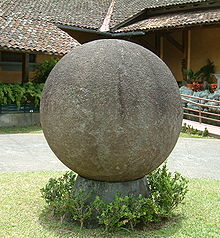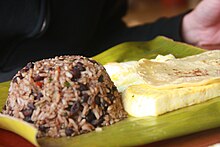Culture of Costa Rica: Difference between revisions
m Reverted edits by 199.104.208.213 (talk) to last revision by SqueakBox (HG) |
No edit summary |
||
| Line 6: | Line 6: | ||
[[File:Costa Rica Pura Vida (2).JPG|thumb|Cultural icons of Costa Rica: coffee, bananas and biodiversity]] |
[[File:Costa Rica Pura Vida (2).JPG|thumb|Cultural icons of Costa Rica: coffee, bananas and biodiversity]] |
||
'''Costa Rican culture''' was heavily influenced by [[Spanish culture]] (considering that Spain colonized and settled what is today known as Costa Rica). While the [[Caribbean]] province of [[Limón]] and the [[Cordillera de Talamanca]] maintain cultures influenced by Jamaican immigrants and indigenous native peoples, respectively.{{Citation needed|date=September 2009}} |
'''Costa Rican culture''' was heavily influenced by the spa[[Spanish culture]] (considering that Spain colonized and settled what is today known as Costa Rica). While the [[Caribbean]] province of [[Limón]] and the [[Cordillera de Talamanca]] maintain cultures influenced by Jamaican immigrants and indigenous native peoples, respectively.{{Citation needed|date=September 2009}} |
||
The official language of [[Costa Rica]] is [[Spanish language|Spanish]], however, there are also many local indigenous languages, such as [[Bribri language|Bribrí]]. English is the first foreign language and the second most taught language in [[Costa Rica]], followed by French, German, Italian and Chinese. A creole language called [[Limón Creole English|Maketelyu]] is also spoken in Limón. |
The official language of [[Costa Rica]] is [[Spanish language|Spanish]], however, there are also many local indigenous languages, such as [[Bribri language|Bribrí]]. English is the first foreign language and the second most taught language in [[Costa Rica]], followed by French, German, Italian and Chinese. A creole language called [[Limón Creole English|Maketelyu]] is also spoken in Limón. |
||
Revision as of 21:43, 20 August 2013
This article possibly contains original research. (November 2007) |


Costa Rican culture was heavily influenced by the spaSpanish culture (considering that Spain colonized and settled what is today known as Costa Rica). While the Caribbean province of Limón and the Cordillera de Talamanca maintain cultures influenced by Jamaican immigrants and indigenous native peoples, respectively.[citation needed]
The official language of Costa Rica is Spanish, however, there are also many local indigenous languages, such as Bribrí. English is the first foreign language and the second most taught language in Costa Rica, followed by French, German, Italian and Chinese. A creole language called Maketelyu is also spoken in Limón.
Ethnic groups
As of 2012[update], most Costa Ricans are of primarily Spanish ancestry with minorities of German, Italian, French, Dutch, British, Swedish and Greek ancestry. Whites, castizos and mestizos together comprise 83% of the population.[2]
European migrants used Costa Rica to get across the isthmus of Central America as well to reach the USA West Coast (California) in the late 19th century and until the 1910s (before the Panama Canal opened). Other European ethnic groups known to live in Costa Rica include Russians, Danes, Belgians, Portuguese, Croats, Hungarians, Turks, Armenians and Georgians.
Many of the first Spanish colonists in Costa Rica may have been[original research?] Jewish converts to Christianity who were expelled from Spain in 1492 and fled to colonial backwaters to avoid the Inquisition. The first sizable group of self-identified Jews immigrated from Poland, beginning in 1929. From the 1930s to the early 1950s, journalistic and official anti-Semitic campaigns fueled harassment of Jews; however, by the 1950s and 1960s, the immigrants won greater acceptance. Most of the 3,500 Costa Rican Jews today are not highly observant, but they remain largely endogamous.[3]
Costa Rica has four small minority groups: Mulattos, Blacks, Amerindians and Asians. About 8% of the population is of Black African descent or Mulatto (mix of European and black) who are called Afro-Costa Ricans, English-speaking descendants of 19th century black Jamaican immigrant workers.
In 1873 the Atlantic Railroad imported 653 Chinese indentured laborers, hoping to duplicate the success of rail projects that used Chinese labor in Peru, Cuba, and the United States. Asians represent 1% of the Costa Rican population, mostly from China, Taiwan and Japan.
There are also over 60,000 Native American or indigenous inhabitants, representing 0.8% of the population. Most of them live in secluded reservations, distributed among eight ethnic groups: Quitirrisí (in the Central Valley), Matambú or Chorotega (Guanacaste), Maleku (northern Alajuela), Bribri (southern Atlantic), Cabécar (Cordillera de Talamanca), Guaymí (southern Costa Rica, along the Panamá border), Boruca (southern Costa Rica) and Térraba (southern Costa Rica).
A considerable portion of the Costa Rican population is made up of Nicaraguans.[4] There are also a number of Colombian refugees. Moreover, Costa Rica took in many refugees from a range of other Latin American countries fleeing civil wars and dictatorships during the 1970s and 80s – notably from El Salvador, Chile, Argentina, Cuba and recently from Venezuela.
Pura vida
Pura vida is a characteristic Costa Rican phrase. It literally means pure life, however, the real meaning is closer to "plenty of life", "full of life", "this is living!", "going great", or "real living".[citation needed] The phrase can be used in many ways; for example, it can be used both as a greeting or a farewell, as an answer expressing that things are going well, or as a way of giving thanks.[5]
According to a researcher from the University of Costa Rica, Víctor Manuel Sánchez Corrales, the origin of the phrase is Mexican (as with other Costa Rican colloquialisms). It is thought to have come from a Mexican film called ¡Pura vida! (1956). The protagonist, played by es, used the expression "pura vida" extensively in situations where it would not normally be used. Costa Ricans adopted the phrase, using it in a similar way. It was formally recognised and incorporated into dictionaries in the mid-1990s.[6]
Religion
Roman Catholicism is recognized as the most popular religion in Costa Rica with 70.2% of the population.[7]
About 44.9% of the population identify themselves as practicing Roman Catholics, 25.6 percent non-practicing Roman Catholics, 13.8 percent evangelical Protestants, 11.3 percent report they do not have a religious affiliation, and 4.3 percent declare "another religion." [1]
The Church of Jesus Christ of Latter-day Saints has a membership of 35,000 members and has a temple in San Jose, that served the country and Panama. The Lutheran Church estimates it has 5,000 members in 30 communities, and the Jewish Zionist Center of Costa Rica estimates there are 2,500 Orthodox Jews and 300 Reformed Jews.[2]
There are several other religious festivals in the country; Costa Rica has various religious denominations: Buddhism, Hinduism, Judaism, Islam, Baha'i Faith, Scientology, Rastafari, Taoism, Jehovah's Witness, and Neopaganism. [citation needed]
Education
Education is highly regarded in Costa Rica by most of the population. About 6% of the country's gross domestic product is dedicated to education,[8] which has produced positive results as 96% of the population is literate. Primary (1st-6th grade) and secondary (7th-11th or 12th) are mandatory for all citizens. Public schools are free, and those who can afford it often opt to send their children to private institutions.[citation needed]
The country has six major public universities: the University of Costa Rica (UCR), the Instituto Tecnológico de Costa Rica (ITCR), the Universidad Nacional (UNA), the Universidad Técnica Nacional, the Universidad Para La Paz, and the Universidad de Educacion a Distancia (UNED).
Art
Painting and sculpture
At the beginning of the 19th century, some wealthy Costa Ricans paid visiting foreign painters, usually European, to paint their portraits.[10] It was not until some of these painters, such as Bigot, Henry Etheridge, or Santiago Paramo settled in the country that Costa Rican artists learned modern techniques for drawing, oil painting, and sculpture.[10] These teachers directly influenced Tico artists Jose Maria Figueroa, Faustino Montes de Oca, or Felipe Valentini.
Towards the end of the 19th century Costa Ricans produced artists with stronger national identities. A short list of these artists would include Ezequiel Jimenez, Wenceslao de la Guardia, and Enrique Echandi. Current renowned Costa Rican painters include Gonzalo Morales Sáurez, Rafa Fernandez, and Fernando Carballo, and sculptors such as Ibo Bonilla, Max Jimenez, Jorge Jimenez Deredia, Domingo Ramos, and Mario Parra.
Music
Most of the music and representative folklore comes from the north of the country, including the Nicoya Peninsula (Mayan culture) and the Atlantic coast (Afro-Caribbean culture). Costa Rican music is marked by a rhythm known as tambito, as well as a distinctive musical genre known as punto. Two examples are the punto guanacasteco from Guanacaste Province, and the sancarleño from San Carlos in Alajuela Province.
Writing
Well known authors include Oscar Núñez Oliva.
Cuisine

Costa Rican cuisine is a combination of Spanish, American, Caribbean, and South American influences. This style of cuisine is shared by most of Central America, although local variations have appeared in each of the countries.
One national dish is gallo pinto ("spotted rooster"), although the name has no relation to the ingredients. It is a combination of black beans and white rice, spiced with cilantro, onions, garlic, salt, and a local condiment called Salsa Lizano. It is typically eaten at breakfast with eggs, and sometimes natilla (sour cream). Fried plantains and either corn tortillas or bread are also common. Gallo pinto is a common and typical dish in both Costa Rica and Nicaragua.
Other typical dishes are arroz con pollo, olla de carne, tamales, and casado. Arroz con pollo (rice with chicken) consists of bite size chicken chunks mixed with rice and diced vegetables that include carrots, peas, corn, and garbanzo beans. Olla de carne is mainly prepared on weekends.[citation needed] It is a broth of corn prepared by boiling water, meat, and whole-to large sized vegetable pieces with spices. The soup is eaten in a bowl with the broth and separate plates for the vegetables and rice. A casado is a one-plate meal that includes black beans, rice, meat, fried plantains, and one or more side dishes. The meat can vary from chicken, beef, or fish. Some examples of side dishes are pasta salad, vegetable salad, fried eggs, potatoes, spaghetti, or barbudos (green beans wrapped in egg batter).[citation needed]
There are some regional differences. For example, the Caribbean side of the country, because of its roots, has gallo pinto with coconut milk, while the north-western part of the country has a strong tendency towards corn products and for large, cheese filled tortillas, corn snacks, and other dishes.
See also
References
- ^ Fabio Mena. La Prensa Libre: Significado de la Plaza de la Justicia, 2007
- ^ Costa Rica. State.gov (2012-04-09). Retrieved on 2012-05-19.
- ^ http://www.everyculture.com/Bo-Co/Costa-Rica.html
- ^ www.state.gov Background Note: Costa Rica – People
- ^ Pura Vida! ¡Hola Costa Rica! In Spanish: "Pura Vida también expresa el momento en que hacemos algo bien sin tratarse de un saludo y una forma de dar las gracias por algo que esté bien."
- ^ La película que nos heredó el ¡pura vida! Nación, 2013-01-05.
- ^ es:Cristianismo por país
- ^ es:Constitución Política de Costa Rica de 1949
- ^ M. A. C. (2012-03-05). "Costa Rica inaugura la escultura más alta del país". CRhoy.com Noticias 24/7. Retrieved 2012-07-25.
- ^ a b http://www.infocostarica.com/culture/painting.html

